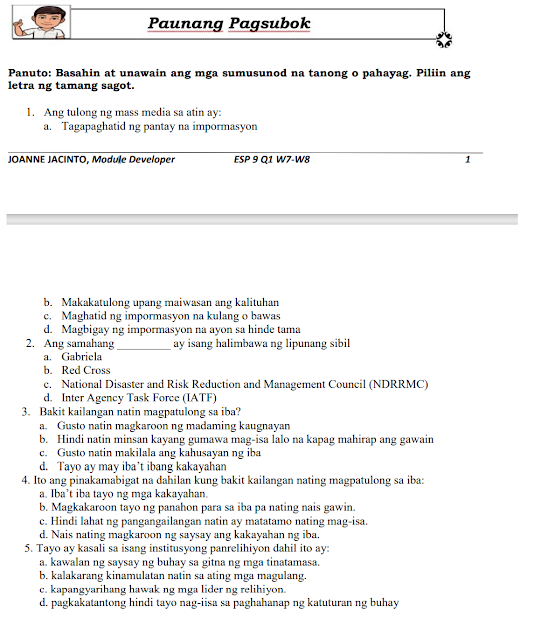REVIEWER IN SCIENCE 1
Reviewer for Science 1 part A
Name:_____________________________________Date:______________Score:_____________
I. Write your answer at the space before the number.
____________________1. This is the result when the earth’s crust is compressed or stressed.
____________________2. It occurs as tectonic plates are pulled apart and the crust become thinner.
¬____________________3. It occurs when the rock break due to the forces acting on them.
____________________4. It is the type of faults when rocks are pulled apart and the crust is stretched.
____________________5. A type of fault occurs when crust is squashed and shortened and form thrust.
____________________6. These are the result from the show deformation of rocks.
____________________7. Himalayas and some highlands is an example of ______________?
____________________8. For numbers 8 & 9 identify the following according to its correct term.
____________________9.
___________________10. When two plates tends to move together or towards each other it undergoes
___________________11. This is the surface above the focus.
___________________12. The amount of force made by a earthquake is called_____?
___________________13. These are the process whereby energy is stored and then break and suddenly released the energy.
___________________14. This is the process when rock changes its shape and volume on size.
___________________15. This the extent of damage during earthquake.
II. Encircle the letter of the correct answer.
1. Which scientist is created with proposing the ideas that led to the development of the plate tectonics theory?
a. Charles Darwin
b. Albert Einstein
c. Isaac Newton
d. Alfred Wegener
2. Which of these layers is found directly above the earth’s core?
a. Asthenosphere
b. Inner Core
c. Mantle
d. Outer Core
3. Which of the following geological events can occur at a transform boundary?
a. Earthquake
b. Mountain formation
c. Volcanic eruption
d. Rift formation
4. Approximately 225 million years ago, the earth’s continents were grouped into one landmass.
a. Europa
b. Jurassic
c. Pangaea
d. Pangaea Ultima
5. Mountain formation can result when which of the following occurs?
a. Two oceanic plate collides
b. Two continental plates collide
c. Two oceanic plates spread apart
d. None of the above
6. What is the earth’s only liquid layer?
a. Asthenosphere
b. Inner core
c. Mantle
d. Outer core
7. What leads to the creation of island arcs?
a. Collision of two oceanic plate
b. Collision of two continental plates
c. Collision of continental and an oceanic plate
d. All of the above
8. What is the earth’s outermost layer?
a. Crust
b. Lithosphere
c. Mantle
d. Outer core
9. This solid layer of the earth is made of mostly iron and nickel.
a. Crust
b. Inner core
c. Mantle
d. Outer core
10. Mid-ocean ridges are places where tectonic plates are doing what?
a. Colliding
b. Sliding past each other
c. Spreading apart
d. None of the above
11. The tectonic plates float on which semiliquid layer?
a. Asthenosphere
b. Crust
c. Inner Core
d. Lithosphere
12. Which of the earth’s layer is broken into severa large tectonic plate?
a. Asthenosphere
b. Crust
c. Lithosphere
d. Outer Core
13. What kind of plate boundary is found at the meeting point of the Philippines and pacific plates?
a. Asian boundary
b. Convergent Boundary
c. Divergent Boundary
d. Transform Boundary
14. What type of crust is found under under the continents?
a. Continental crust
b. Oceanic crust
c. Geologic crust
d. None of the above
15. What is not likely to happen at a divergent boundary?
a. Mountain formation
b. Rift valley
c. Seafloor spreading
d. Volcanic formation
16. What type of crust is found under the oceans?
a. Continental crust
b. Oceanic crust
c. Geologic crust
d. None of the above.
17. Which of these concepts is part of the theory of plate tectonics?
a. Continents are fixed and don’t move
b. A great flood shaped the earth’s surface
c. Continents are in slow constant motion
d. None of the above.
18. When did the supercontinent Pangaea start to break p?
a. 20 million years ago
b. 40 million years ago
c. 100 million years ago
d. 200 million years ago
III. ROCK CYCLE. Complete the missing part of the diagram.
1. Which of this statement is true?
a. Weathering and erosion affects all rocks on the earth’s surface
b. Weathering and erosion only affects sedimentary rocks on the earth’s surface
c. Weathering and erosion affects all rocks under the earth’s surface
d. Rocks are un affected by weathering and erosion
2. Which characteristics are found in sedimentary rocks?
a. Crystals b. fossils c. Gas bubbles d. glassy surface
3. Which of the following is NOT one of the three major classes of rocks?
a. Igneous rocks
b. Metamorphic rocks
c. Oceanic rocks
d. Sedimentary rocks
4. The sculpture of President Lincoln inside the Lincoln memorial was carved out of white Georgia marble. What type of rock is marble?
a. Igneous
b. Sedimentary rocks
c. Metamorphic rocks
d. None of the above
5. The interrelationship among the three rock type is identified as which of the following?
a. Rock cycle
b. Rock formation
c. Rock helix
d. Rock metamorphosis
6. When magma is cooled, it changes into which of the following?
a. Igneous rocks
b. Metamorphic rocks
c. Sedimentary rocks
d. Legendary rocks
7. When melting of metamorphic rock occurs, it changes into which of the following?
a. Igneous rocks
b. Lava
c. Magma
d. Sedimentary rocks
8. When heat and pressure are applied to sedimentary rocks, it changes into which of the following?
a. Igneous rocks
b. Metamorphic rocks
c. Sedimentary rocks
d. National rocks
9. When sediments are compacted and cemented, it changes into which of the following?
a. Igneous rocks
b. Metamorphic rocks
c. Sedimentary rocks
d. Legendary rocks
10. When rocks are affected by weathering and erosion, they change into which of the following?
a. Lava
b. Magma
c. Sediments
d. Soil


Mga Komento